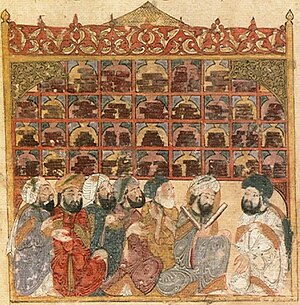House of Wisdom (Baghdad)
The House of Wisdom ( Arabic بيت الحكمة Bayt al-Hikma , DMG bait al-ḥikma ) was a kind of academy foundedin Baghdad in 825 by the Abbasid caliph al-Ma'mūn . The much older Academy of Gundischapur served as a model for the House of Wisdom.
In the House of Wisdom around 90 people worked at times on scientific translations , mainly from Greek, but also from Aramaic and Persian into Arabic. Al-Ma'mūn sent a scholar from his court to Byzantium and asked the emperor to give him mathematical works (including those of Euclid ). All of the ancient works that could be found were translated in the house, including those by Galen , Hippocrates , Plato , Aristotle , Ptolemy and Archimedes. Under the direction of the Christian doctor Hunayn ibn Ishaq , they also developed a technique of conceptual instead of literal translation. His son Ishāq ibn Hunain also worked here as a translator of Euclid's elements with the mathematician and astronomer Thabit ibn Qurra, who also worked there .
According to the historian Ibn al-Qifti, 37 Christians, 8 Sabeans and 9 Jews worked in Baghdad at the time the house was built . Due to their specialist knowledge and language skills, they were important for building the house. In addition to the aforementioned Hunain ibn Ishaq and Thabit ibn Qurra, the staff included al-Abbas ibn Said al-Jawhari , the philosopher al-Kindī , the Banū Mūsā brothers and the mathematician al-Chwarizmi .
In addition to the translation center, the House of Wisdom also includes an observatory, an academy and a rich library as well as a hospital. Following the example of the institution, similar institutions were created in Córdoba and Seville . The Fatimid caliph al-Hakim had a house of wisdom set up in Cairo around 1000 .
Baghdad was conquered by the Mongols under Hülegü in 1258 after a brief siege , and the House of Wisdom was destroyed along with all the other libraries.
The establishment of the house was favored by the development of paper production in the Arab region. At that time a paper mill was being built in Baghdad. On the Suq al-Warraqin , the paper market, there were 100 paper shops , some of which, run by teachers and writers, were small science and literature centers of their own. The most famous paper dealers were Ahmad ibn Abi Tahir (819-893) and Abu l-Faraj Muhammad ibn Ishaq (d. 995).
See also
literature
- Marie-Geneviève Guesdon: Le Bayt Al-Hikma de Baghdad. In: Arabica. Revue d´études Arabes. Volume 39, 1992, ISSN 0570-5398 , pp. 131-150
-
Jim Al-Khalili : Pathfinders. The Golden Age of Arabic Science. Allen Lane, London 2010, ISBN 978-1-84614-161-4 .
- German: In the house of wisdom. The Arab sciences as the foundation of our culture. Translated from English by Sebastian Vogel S. Fischer Verlag, Frankfurt am Main 2011, ISBN 978-3-10-000424-6 , Chapter 5.
- Cristina D'Ancona Costa : La casa della sapienza. La trasmissione della metafisica greca e la formazione della filosofia araba (= Socrates 18). Guerini e Associati, Milano 1996, ISBN 88-7802-702-2 .
Individual evidence
- ↑ Jonathan M. Bloom: Revolution by the Ream. A History of Paper. In: Aramco World magazine. Vol. 50, No. 3, May / June 1999, ISSN 0146-4132 , pp. 26-39 (German: A revolution in arches. Translated from the American by Karl-Heinz Ziessow). online ( Memento of the original from October 24, 2006 in the Internet Archive ) Info: The archive link was inserted automatically and has not yet been checked. Please check the original and archive link according to the instructions and then remove this notice. .
